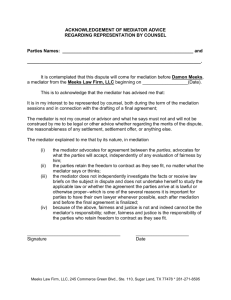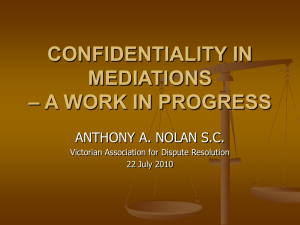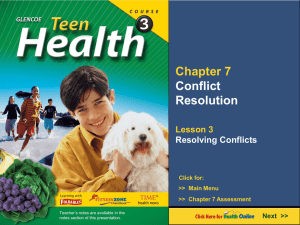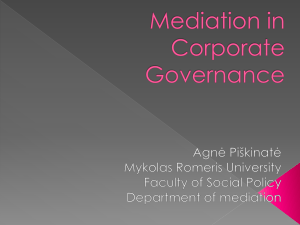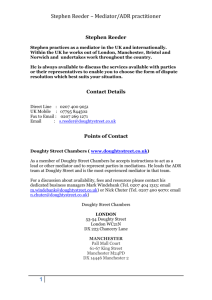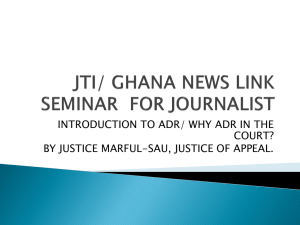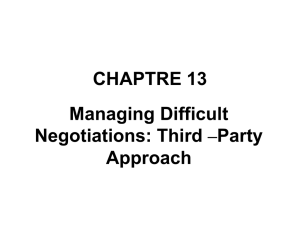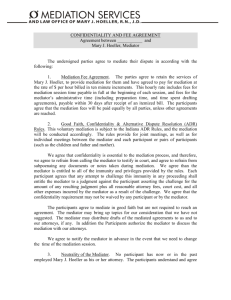Trends in U.S. Mediation - University of Stellenbosch Business School
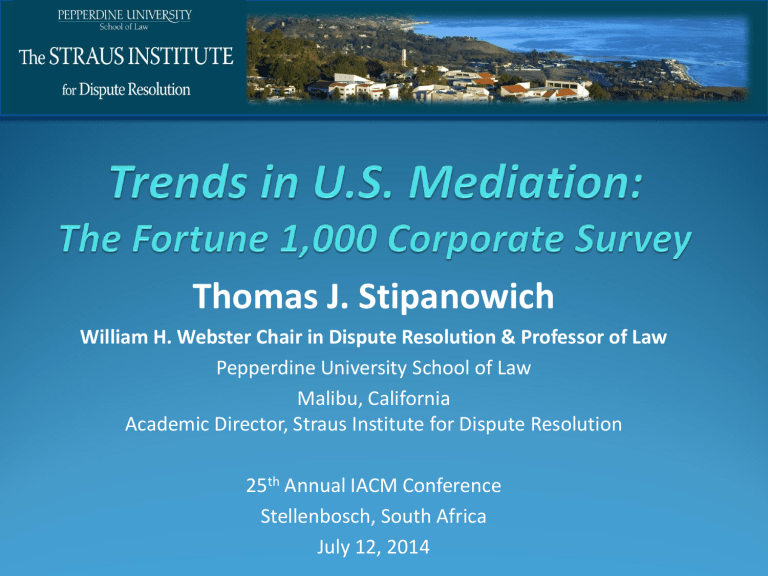
Thomas J. Stipanowich
William H. Webster Chair in Dispute Resolution & Professor of Law
Pepperdine University School of Law
Malibu, California
Academic Director, Straus Institute for Dispute Resolution
25 th Annual IACM Conference
Stellenbosch, South Africa
July 12, 2014
The Fortune 1,000 Corporate Survey (2011)
Co-sponsored by Straus Institute for Dispute
Resolution with the Scheinman Institute on Conflict
Resolution at Cornell University and the International
Institute for Conflict Prevention & Resolution (CPR)
Landmark survey of Fortune 1,000 companies and federal agencies, following on 1997 Cornell PERC
Survey of Fortune 1,000 companies
Thanks to Prof. David Lipsky (Cornell) and Beth Trent
(CPR) for portions of this presentation.
Backdrop: U.S. Litigation
98.8% of federal civil cases settle before trial
(2009)
Litigation represents more than half of legal budget ($21.1B annual litigation spend in US)
14.3% of companies control 80% of litigation spending
Great cost is associated with discovery
International Institute for Conflict
Prevention & Resolution 4
Crisis in U.S. Courts
State Courts
Most states cut funding 10%-15%
26 state courts delayed judgeships
14 states massive layoffs
NY and CA hardest hit
Federal Courts
9.5% district judge vacancy rate
Criminal cases up 70%
Google/Oracle dispute delayed due to criminal trial
The Fortune 1,000 Corporate Survey (2011)
Co-sponsored by Straus Institute for Dispute Resolution with Cornell University and the International Institute for
Conflict Prevention & Resolution (analysis in progress)
Landmark survey of Fortune 1,000 companies and federal agencies, following on 1997 Cornell PERC Survey of Fortune
1,000 companies
Objectives of the Study
• To obtain information regarding mediation, arbitration, and other ADR techniques used by major U.S. corporations
• To identify trends comparing the results with the results
Cornell obtained in a 1997 Fortune 1000 survey
• To discover emerging policies and practices in the use of
ADR by major corporations
• To understand the factors that explain the trends and patterns we have discovered in the use of ADR
Survey Design and Methodology
• The survey was administered by Cornell’s Survey Research
Institute
• Conducted interviews with top attorneys in 368
corporations -- 37.4% response rate (1997 survey received
606 responses)
• 46 percent of the respondents were GCs and 54 percent were other attorneys in the GC’s office
• Respondents had the choice of completing the survey by phone, by mail, or by web
Survey Administration and Response Rate
Total Number of Surveys
Completed survey*
368
360
By mail
By phone
By web
Partially completed survey ̊
Out of business (Company defunct, merged or acquired)
Contacted without resolution
Refused to participate
8
16
332
284
85
63
212
Response Rate 37.4%
*Includes 6 completes from pilot study
Proportion of Companies that Used Technique at Least Once in the Previous 3 Yr.
100%
90%
80%
70%
60%
50%
40%
30%
20%
10%
0%
85%
97%
20%
28%
80%
83%
40%
47%
10%
13%
20%
14%
37%
36%
33%
63%
10%
16%
1997
2011
*
These options were only included in the 2011 study
Principal Reasons Companies Use ADR, 2011
80%
70%
60%
50%
40%
30%
20%
10%
0%
71%
69%
44%
26%
38%
55%
52%
Saves time Saves money Preserves good relationships
More satisfactory settlements
More satisfactory process
Court mandated
Allows parties to resolve disputes themselves
Percent of Responding Companies that Used Mediation at Least Once in Each Type of Dispute in the Previous 3 Years
50%
40%
30%
20%
10%
0%
90%
80%
70%
60%
24%
26%
79%
81%
78%
80%
13%
17%
31%
28%
29%
41%
57%
58%
39%
38%
32% 32%
39%
26%
10%
14%
1997
2011
Percent of Responding Corporations that Used Arbitration at Least Once in
Each Type of Dispute in the Previous Three Years
90%
80%
70%
60%
50%
40%
30%
20%
10%
0%
17%
12%
62%
36%
85%
60%
12%
10%
20%
9%
21%
14%
32%
22%
23%
10%
26%
13%
40%
14%
8% 8%
1997
2011
90%
80%
70%
60%
50%
40%
30%
20%
10%
0%
Percent of Responding Companies that Used Mediation at Least Once in Each Type of Dispute in Previous Three Years (2011)
81% 80%
58%
41%
26%
17%
28%
38%
32%
26%
14%
Typical Comments
“We use mediation a lot more than we use binding arbitration.”
“Lack of qualified neutrals is not ordinarily an issue in mediation.”
“Mediation is not complicated…people are familiar with it. “
“I am less concerned about third-party neutrals since I can still control the outcome.”
“Mediation is not binding, less risk.”
Resolving Employment Disputes
“What Proportion of Your Employees are Covered by ADR?”
Proportion of Employees
More than 75 percent
Percentage of Companies
19.0%
Between 51 and 75 percent
Between 26 and 50 percent
Between 1 and 25 percent
Zero
Don’t know
3.5%
3.5%
19.4%
43.3%
11.3%
The Five Characteristics of Integrated Conflict
Management Systems
Broad Scope
Tolerant Culture
Multiple Access Points
Multiple Options
rights-based
interest-based
Systemic Support and Structures
Source: Guidelines For The Design of Integrated Conflict Management Systems Within Organizations, SPIDR’s ADR in the Workplace Track I Committee, 2000.
Do You Believe Your Company Has a “Conflict
Management System”?
This result is inconsistent with our other findings: 67 percent of the companies say they have a “system” but only 46 percent say their employees are covered by ADR!
Does Your Company Have an Office or “Function”
Dedicated to Managing Your Dispute Resolution Program?
This finding together with other findings in our survey suggest that about one-third of major U.S. Corporations have an “integrated conflict management system”
Conclusions
Over the past 15 years, a growing number of companies have adopted ADR as their principal approach to resolving consumer, commercial, and employment disputes
Many companies have adopted a wider array of ADR
techniques, including early neutral evaluation, early case assessment, and conflict coaching
Companies have moved from using ADR techniques primarily to avoid litigation to using ADR techniques to resolve disputes at the earliest possible stage
Although the use of ADR techniques has generally grown, the use of arbitration has significantly declined.
Conclusions
Surprisingly, four out of ten respondents report that they do
not use ADR to resolve employment disputes
On the other hand, we estimate that one-third of the
Fortune 1000 corporations now have an integrated conflict management system (ICMS)
Relatively speaking, the number of corporations with an
ICMS has doubled over the last 15 years
It appears that a growing proportion of major corporations are adopting sophisticated conflict management strategies, but a significant proportion continue to use more traditional methods
Thomas J. Stipanowich
William H. Webster Chair in Dispute Resolution & Professor of Law
Pepperdine University School of Law
Malibu, California
Academic Director, Straus Institute for Dispute Resolution
25 th Annual IACM Conference
Stellenbosch, South Africa
July 12, 2014
Mediation Outcomes in Relationship Cases
(Golann, 2002)
How construction mediators are selected
Dean Thomson, ABA Forum Survey, Constr. Lwyr. (Fall 2001)
Criteria for selection from outside the region
1=highest in importance; 5=lowest
Score Criterion
2.36
2.86
2.89
3.73
3.94
4.88
5.71
Mediator subject matter experience
Mediator reputation
Mediation experience
Acceptability to all parties
Mediation style
Mediator’s legal expertise
Expense of mediator
If mediator has experience in mediation and the subject matter, I prefer…
I prefer:
Preparatory approaches
Beginning the joint session
Handling complex, multi-party disputes
Significant early planning and preparation, including
Exchange of statements
Submission of confidential settlement positions to mediator
Premediation meeting with lawyers to set ground rules
Exchange key documents, etc.
Mini-mediations
Preferred mediator activities
(10 is highest ranking)
Activity Want to receive
4.5
Asks parties to confidentially evaluate their cases, but does not evaluate.
Will not let the parties leave unless the mediator declares an impasse.
At an appropriate time during the mediation, forcefully and vigorously recommends a resolution proposed by one of the parties or the mediator.
6.0
6.3
Reviews with the parties the likely costs and expenses of proceeding and the uncertainties of the legal process.
6.5
Typically receive
5.0
4.2
4.8
7.2
Preferred mediator activities
(10 is highest ranking)
Activity Want to receive
7.1
At an appropriate time during the mediation, forcefully and vigorously reviews with each party in confidence the mediator’s opinion of the likely outcome of the case.
At an appropriate time during the mediation, encourages the parties to accept a resolution proposed by one of the parties or the mediator.
Communicates the parties’ settlement positions and helps the parties avoid personality disputes.
7.3
8.1
Typically receive
5.1
6.2
6.9
Preferred mediator activities
(10 is highest ranking)
Activity
Confidentially discusses with each party the merits and potential outcomes of the case.
Want to receive
8.4
Typically receive
6.7
Presents various settlement options or solutions to the various parties based on the mediator’s understanding of the case.
8.9
6.0
If the mediator is to provide a confidential evaluation of my client’s case, I prefer:

